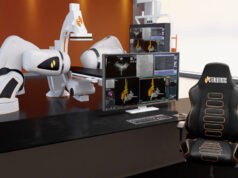
Thanks to the use of robotics in healthcare, many procedures that were once highly invasive are now being performed using minimally invasive techniques, with the added benefits of precision and radiation protection. Jean Fajadet looks at how the technology works, and what it can bring to the cath lab.
Medical robotics has become a useful tool to improve physicians’ capabilities, especially in the catheterisation laboratory. Precision and accuracy in vascular procedures in cardiology are vital for success and patient safety, and the incorporation of robotic devices into procedures such as percutaneous coronary intervention (PCI) has led to some notable successes.
How robotic-assisted PCI works
A robotic‐assisted PCI device uses guide wires, balloons, and stents and is operated from a radiation-protected control console. Two robotic PCI systems are currently available on the market—CorPath GRX (Corindus Vascular Robotics) which has been FDA cleared and CE marked, and R-One (Robocath) which is CE Marked. The CorPath GRX System includes an arm, a robotic drive, and a single‐use cassette, into which the guiding catheter, wires, balloons, and stents are loaded. The control center consists of the physician cockpit, which is lead lined to protect from radiation. Alternatively, the control center can be set up within the cath lab’s control room. During a PCI procedure, the cardiologist sits within the shielded cockpit or control room. The system allows the operator in the cockpit or control room to manipulate the guiding catheter, the guidewire, and the balloon or stent using a set of three joysticks and touch screen controls, closely visualising movement on a 4K resolution monitor.
Benefits of robotic-assisted technology
Hospitals around the world install robotic devices such as the CorPath GRX System to perform minimally invasive vascular procedures with instruction from expert physicians. Before the development of robotic devices, physicians were, and still are, exposed to taxing conditions and high levels of radiation subsequently resulting in cancers, orthopedic issues, and cataracts. Robotic devices can reduce radiation exposure by upwards of 95% for the operating physician, while potentially reducing the orthopaedic stress associated with long, straining procedures and heavy lead vests that must be worn to comply with protocol.
Further major benefits of robot‐assisted PCI include improved operator, patient, and staff safety, procedural control, and precision. Robotic devices allow millimeter device movements and sub-millimeter device positioning, providing optimal stent positioning, and have the potential to bring significant clinical, safety, and financial benefits to hospitals.
The development of robotic-assisted PCI
The use of robotic‐assisted PCI has grown rapidly around the world, and is now also taking off in Europe. In addition to their potential to dramatically change interventional cardiology, in the future, robotic systems may make interventions possible in isolated and underprivileged locations through remote operation, improving both access to highly-skilled medical professionals and patient outcomes.
Putting technology into practice
To demonstrate this widespread adoption, I was able to validate the benefits of robotic-assisted PCI with CorPath GRX at EuroPCR 2019 (20–24 May, Paris, France). We successfully performed a live complex robotic-assisted PCI procedure from Clinique Pasteur in Toulouse, France, and broadcasted it live to EuroPCR attendees. This marked the first time a procedure using a robotic-device, such as CorPath GRX, was performed and broadcast live in Europe. Our facility has become the first site in Europe to adopt the vascular robotic technology of the CorPath GRX System — a step we took to improve the safety of our staff and patients.
In just a few short months, we have demonstrated the positive impact of a high-tech care model to the clinical community in Europe. The live case went exactly as planned, as I was able to complete the procedure with control of all interventional devices while managing the lab from the control room.
Future expectations—remote
Maybe the most valuable application of robotic‐assisted PCI systems will come when robotic technology is able to support remote capabilities, allowing us to treat patients across highly dispersed geographies from one central location. As robots become more capable, robotic systems can help to reduce the costs of catheterisation laboratories in remote areas, allowing a smaller number of physicians to control multiple remote sites using telemedicine. This model has already been implemented in areas such as diagnostic radiology, and the technology will soon have the capability to conduct interventional procedures across multiple specialties.
Jean Fajadet is at Clinique Pasteur, Toulouse, France.













